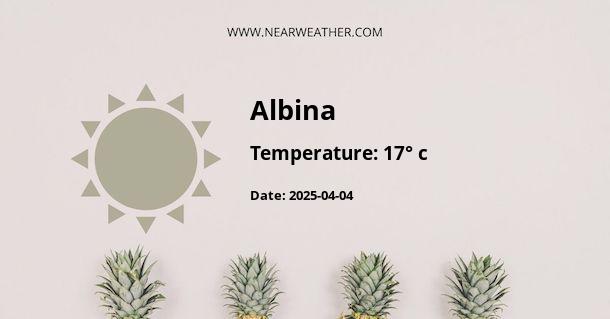Climate and Weather of Albina, Italy: An In-Depth Look at Seasonal Patterns
Albina, a charming locale in Italy, stands out for its idyllic setting and distinctive weather patterns that reflect the allure of the Mediterranean climate. Known for its picturesque landscapes, Albina offers a blend of mild winters and warm, dry summers that appeal to residents and tourists alike. In this comprehensive guide, we delve into the meteorological specifics of Albina, observing how its climate shapes the daily life and seasonal activities in the area.
Geographical Context of Albina's Climate
Located in Italy, Albina benefits from its position within the Mediterranean region, which is characterized by its unique geographical features influencing the local climate. The proximity to bodies of water, varied elevation, and latitudinal position all contribute to the atmospheric conditions experienced in this region.
Understanding Albina's Climate Classification
The Köppen climate classification system identifies the climate of Albina as Csa—Mediterranean, with mild, wet winters and hot, dry summers. This classification plays a crucial role in the area's agricultural practices, biodiversity, and the overall lifestyle of its inhabitants.
Year-Round Weather Conditions
The following sections break down Albina's weather conditions by seasons, offering insight into temperature fluctuations, precipitation patterns, and other meteorological phenomena specific to each part of the year.
Spring in Albina
Spring in Albina is a season of renewal and a gradual transition from the cooler temperatures of winter to the warmer days of summer. March usually starts with mild temperatures, which progressively increase as the season advances.
- March: Average high 14°C (57°F), Average low 7°C (45°F)
- April: Average high 18°C (64°F), Average low 10°C (50°F)
- May: Average high 23°C (73°F), Average low 14°C (57°F)
Precipitation in spring varies, with occasional showers fostering the growth of vibrant flora. Albina's landscapes turn picturesque with wildflowers blooming against the backdrop of its historic architecture.
Summer in Albina
The warmth and sunshine of summer offer a classic Mediterranean experience. With minimal rainfall and abundant sunny days, outdoor activities and leisure pursuits such as visiting vineyards and coastal expeditions become a mainstay.
| Month | Average high | Average low |
|---|---|---|
| June | 28°C (82°F) | 18°C (64°F) |
| July | 31°C (88°F) | 21°C (70°F) |
| August | 31°C (88°F) | 21°C (70°F) |
The summer climate in Albina is conducive to grape maturation, and thus, the season plays a significant role in the local winemaking tradition.
Autumn in Albina
Autumn brings a respite from the heat with cooler temperatures and increased precipitation. It's a season that showcases the region's changing foliage, creating a picturesque scene for residents and photographers.
- September: Average high 26°C (79°F), Average low 17°C (63°F)
- October: Average high 21°C (70°F), Average low 13°C (55°F)
- November: Average high 15°C (59°F), Average low 8°C (46°F)
The harvest season commences, and the local communities engage in collecting the bounties of their agricultural labor, including olives and grapes, which are central to Albina's economy.
Winter in Albina
Winter months are characterized by a noticeable dip in temperature, but rarely does it reach freezing point. The milder winter, compared to northern Italy or other parts of Europe, allows for enjoyable sightseeing and continued agricultural activity.
| Month | Average high | Average low |
|---|---|---|
| December | 11°C (52°F) | 5°C (41°F) |
| January | 10°C (50°F) | 4°C (39°F) |
| February | 11°C (52°F) | 4°C (39°F) |
While snowfall is rare, rain is more frequent, replenishing the water reserves and preparing the soil for spring planting.
Factors Influencing Albina's Weather
Several factors contribute to the climate patterns of Albina:
- Proximity to the Sea: Albina's closeness to the Mediterranean Sea helps temper the extremes of both summer heat and winter cold.
- Altitude: The varying altitudes in the region can cause microclimates, where higher elevations experience cooler temperatures.
- Air Currents: Prevailing winds from the sea bring moisture, while continental winds can lead to drier conditions.
Climate Change Impacts on Albina
Climate change is altering weather patterns globally, and Albina is experiencing its effects through:
- Incremental temperature rise, leading to more intense and frequent heatwaves.
- Changes in precipitation distribution, posing challenges to traditional farming cycles.
- Sea level rise impacting coastal zones and ecosystems.
Local policymakers and communities are increasingly aware of these shifts and are adapting through sustainable practices and infrastructure development.
Conclusion
The climate and weather of Albina play an integral role in the region's way of life. From the vernal freshness of spring to the verdant harvest of autumn, Albina's climate fosters deep-rooted traditions and a lifestyle in harmony with the environment. Understanding the patterns and influences on this sublime Mediterranean climate further enriches the appreciation for this Italian jewel.
A - Albina's Latitude is 45.832779 & Longitude is 12.467220.
A - Weather in Albina is 18° today.
A - Climate Conditions in Albina shows broken clouds today.
A - Humidity in Albina is 65% today.
A - Wind speed in Albina is 7.7 km/h, flowing at 63° wind direction. today.
